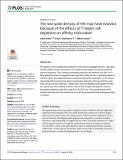The low spike density of HIV may have evolved because of the effects of T helper cell depletion on affinity maturation
Author(s)
Amitai, Assaf; Kardar, Mehran
Downloadjournal.pcbi.1006408.pdf (2.065Mb)
PUBLISHER_CC
Publisher with Creative Commons License
Creative Commons Attribution
Terms of use
Metadata
Show full item recordAbstract
The spikes on virus surfaces bind receptors on host cells to propagate infection. High spike densities (SDs) can promote infection, but spikes are also targets of antibody-mediated immune responses. Thus, diverse evolutionary pressures can influence virus SDs. HIV's SD is about two orders of magnitude lower than that of other viruses, a surprising feature of unknown origin. By modeling antibody evolution through affinity maturation, we find that an intermediate SD maximizes the affinity of generated antibodies. We argue that this leads most viruses to evolve high SDs. T helper cells, which are depleted during early HIV infection, play a key role in antibody evolution. We find that T helper cell depletion results in high affinity antibodies when SD is high, but not if SD is low. This special feature of HIV infection may have led to the evolution of a low SD to avoid potent immune responses early in infection.
Date issued
2018-08Department
Institute for Medical Engineering and Science; Massachusetts Institute of Technology. Department of Chemical Engineering; Massachusetts Institute of Technology. Department of Physics; Ragon Institute of MGH, MIT and HarvardJournal
PLOS Computational Biology
Publisher
Public Library of Science
Citation
Amitai, Assaf, Arup K. Chakraborty, and Mehran Kardar. “The Low Spike Density of HIV May Have Evolved Because of the Effects of T Helper Cell Depletion on Affinity Maturation.” Edited by Claus O. Wilke. PLOS Computational Biology 14, no. 8 (August 30, 2018): e1006408.
Version: Final published version
ISSN
1553-7358
1553-734X